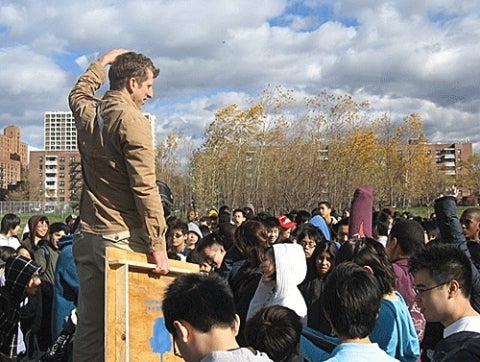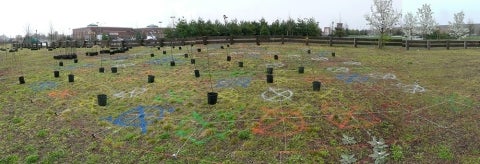Note: Yale School of the Environment (YSE) was formerly known as the Yale School of Forestry & Environmental Studies (F&ES). News articles and events posted prior to July 1, 2020 refer to the School's name at that time.
Earlier this year, Alexander Felson suggested that the field of urban design would improve markedly if ecologists became more involved. But as Felson conceded, many ecologists have scant experience working on development projects and might not even know where to begin.
In a new article, Felson, an assistant professor at the Yale School of Forestry & Environmental Studies and the Yale School of Architecture, lays out a “roadmap” for integrating ecology into urban design. Writing in the journal BioScience, Felson describes strategies for ecologists to inject themselves into design projects — such as urban parks and buildings — and highlights critical moments in the process when they can have the greatest impact.
In a new article, Felson, an assistant professor at the Yale School of Forestry & Environmental Studies and the Yale School of Architecture, lays out a “roadmap” for integrating ecology into urban design. Writing in the journal BioScience, Felson describes strategies for ecologists to inject themselves into design projects — such as urban parks and buildings — and highlights critical moments in the process when they can have the greatest impact.
 <p class="p1"> Alex Felson leads a tree-planting effort by students at a Queens park as part of the New York City Afforestation Project. </p>
<p class="p1"> Alex Felson leads a tree-planting effort by students at a Queens park as part of the New York City Afforestation Project. </p>
“The biggest challenge that ecologists face in getting involved in the design process is simply a lack of understanding what the process entails,” Felson said. “Part of the challenge is that the design process is iterative, unpredictable and often not linear. However, by providing a simplified linear representation of the process, we have created a roadmap that ecologists can use to interpret the process and to inform their own strategies and participation in a project.”
In the article, Felson and seven other authors — including ecologists, designers, engineers and regulators — identify the specific stages of a typical development project, from the contract phase to site evaluation, design, construction and post-occupancy.
While environmental consultants frequently provide expertise in urban design projects, they typically don’t conduct primary research that can shape the direction of a project, Felson says. Under the right circumstances, he says, an ecologist can have far more input.
In the article, Felson and seven other authors — including ecologists, designers, engineers and regulators — identify the specific stages of a typical development project, from the contract phase to site evaluation, design, construction and post-occupancy.
While environmental consultants frequently provide expertise in urban design projects, they typically don’t conduct primary research that can shape the direction of a project, Felson says. Under the right circumstances, he says, an ecologist can have far more input.
It’s ideal to get involved early in the contract phase because essentially you’re carving out your role in a project.
A critical first step is identifying potential clients and projects that will prioritize ecology-based research goals as part of the project. If ecologists are involved from the beginning, they can help define the budget, project length (allowing enough time for project-specific research), and performance goals.
“It’s ideal to get involved early in the contract phase because essentially you’re carving out your role in a project,” Felson said. “If you don’t carve out your role then, you’re left trying to fit it into the project later on someone else’s dime.”
Once the ecologist’s role is established, they can engage with designers on decisions that affect research, including design and construction, allowing the scientist an opportunity to promote and test sustainable design solutions.
According to the authors, this occurred during the implementation of MillionTreesNYC, an infrastructure project funded by the New York City Department of Parks and Recreation that ultimately included a long-term research component. While city officials originally planned to monitor only tree survival as part of the project, the hired landscape architects (including Felson) sought to embed a research experiment to also assess the health and resiliency of the planted trees. Doing so, they reasoned, would improve future park management decisions and save money.
“The partnership during the design and construction phases led to the establishment of an urban forestry experiment that enhanced the original goals of the request for proposals,” the authors write.
“It’s ideal to get involved early in the contract phase because essentially you’re carving out your role in a project,” Felson said. “If you don’t carve out your role then, you’re left trying to fit it into the project later on someone else’s dime.”
Once the ecologist’s role is established, they can engage with designers on decisions that affect research, including design and construction, allowing the scientist an opportunity to promote and test sustainable design solutions.
According to the authors, this occurred during the implementation of MillionTreesNYC, an infrastructure project funded by the New York City Department of Parks and Recreation that ultimately included a long-term research component. While city officials originally planned to monitor only tree survival as part of the project, the hired landscape architects (including Felson) sought to embed a research experiment to also assess the health and resiliency of the planted trees. Doing so, they reasoned, would improve future park management decisions and save money.
“The partnership during the design and construction phases led to the establishment of an urban forestry experiment that enhanced the original goals of the request for proposals,” the authors write.
Land development is inevitable... and it’s happening with less ecological assessment than it should be. The more we can get ecologist involved the better.
While conceding that funding agencies are sometimes skeptical about granting a major role to researchers — since it can increase a project’s cost and duration — the paper suggests that ecologists can strategically integrate research into design and engineering. They argue that ecologists should assert the value of ecological research: “The urban ecology researcher will benefit both from studying a system in order to better shape that system and from shaping a system in order to better study it.”
The integration of research into urban design will require some compromises, Felson says. For starters, their research will sometimes support the development of pristine environments. However, their involvement also presents an opportunity to integrate current research into the design of the urban built environment.
“Land development is inevitable,” Felson said. “It’s happening all over the world, and it’s happening with less ecological assessment than it should be…The more we can get ecologists involved in land development the better.”
If done right, he added, increased interaction between ecologists and urban designers could transform the design profession, and ultimately encourage more sustainable landscape and construction projects.
The integration of research into urban design will require some compromises, Felson says. For starters, their research will sometimes support the development of pristine environments. However, their involvement also presents an opportunity to integrate current research into the design of the urban built environment.
“Land development is inevitable,” Felson said. “It’s happening all over the world, and it’s happening with less ecological assessment than it should be…The more we can get ecologists involved in land development the better.”
If done right, he added, increased interaction between ecologists and urban designers could transform the design profession, and ultimately encourage more sustainable landscape and construction projects.
The article, “Mapping the Design Process for Urban Ecology Researchers,” which appears in the current issue of BioScience, was co-authored by seven other authors, including Nikki Springer of the Yale School of Forestry & Environmental Studies.
Felson, Alexander J., Mitchell Pavao-Zuckerman, Timothy Carter, Franco Montalto, Bill Shuster, Nikki Springer, Emilie K. Stander, and Olyssa Starry. "Mapping the Design Process for Urban Ecology Researchers." BioScience (2013)
– Kevin Dennehy kevin.dennehy@yale.edu 203 436-4842
 <p class="p1"> The MillionTreesNYC site in Spring Creek, Queens.</p>
<p class="p1"> The MillionTreesNYC site in Spring Creek, Queens.</p>
Published
November 6, 2013